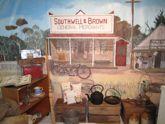O'Donovan, Nanno
Family background
Nanno O'Donovan was born c1850 in County Waterford, Ireland, and moved to Australia with two siblings as a young woman. Although untrained, a reference from Queanbeyan's Catholic priest, Rev James McAuliffe, (who helped establish several schools in the area), was enough to initiate her long but often problematic career.
Fell Timber/Kohan Provisional School
In February 1875, Nanno was recognised as inaugural teacher at Fell Timber (later known as Kohan), a short-lived school between Queanbeyan and Bungendore. Nanno seemingly worked hard and the residents were satisfied with her. At school inspection in 1877 there were 17 pupils who were praised for good manners and satisfactory attainments. In 1878 she applied for a position in the Braidwood District, perhaps to be nearer her sisters Ellen (a teacher), and Kate (wife of a hotel keeper), but there were no vacancies. Soon after this, as Kohan faced closure, Rev McAuliffe suggested Nanno for a new school at Yarralumla (Bulga Creek).
Yarralumla (Bulga Creek) Provisional/Public School
In December 1878, Nanno began at Yarralumla with books and other property from Kohan. By March 1880 there were 37 students enrolled and it was recommended Yarralumla become a Public School under charge of a classified teacher, although the local inspector warned that residents would be 'loud in their complaints' if Nanno was removed. She was therefore allowed to remain on condition that she passed a classification examination within 12 months. Around this time, she fruitlessly applied for repairs to the school, the inspector judging it 'not a whit worse or better than the average'. As the date for her classification exam approached, she appealed for an extension due to ill health, but before the revised date arrived, a poor inspection report saw her moved to a smaller school.
Foxlow Provisional School
In November 1882 Nanno began at Foxlow (also spelt Foxlowe) near Captains Flat, reopening after extended closure with expected enrolment of 20. Within four months, she applied for removal due to ill health, her departure seen as 'a serious loss to pupils ... on account of her indefatigable zeal and firm but kind demeanour as a teacher' ['Goulburn Evening Penny Post', 4 September 1883, p. 4].
Currans Creek Provisional School
In August 1883 Nanno was appointed to Currans Creek near Crookwell, formerly a half-time school. Enrolments gradually increased and her teaching endeavours were favourably regarded by the community, with one observer noting 'Miss Donovan (sic) has reason to be proud of the progress made by the pupils under her charge' ['Crookwell Gazette', 7 May 1886, p. 2]. Despite her good rapport, after three years she asked for removal to a school with a residence, an optimistic request since such situations were chiefly given to classified married male teachers.
Mid-career appointments (1887-1901)
As Nanno approached 40 years old, she had been teaching for twelve years, but had never attempted a classification exam. The reason for her reluctance in this matter is unknown, but it meant she was only eligible for low-ranked appointments earning minimum remuneration. In March 1887 she received temporary appointment to Mimosa Dell in the Oberon district, a locality she described as 'outlandish'. There was a school residence but its condition was so dilapidated she swiftly organised repairs but had trouble claiming reimbursement as she had acted without approval. Another problem arose as a resident regularly left school gates open for stock to pass through, resulting in Nanno's own cow and horse straying, and causing such ill-feeling that Nanno was recommended for removal. In 1890 she held temporary positions at Rock Villa near Adaminaby, then Cooma, which raised her annual salary from £88 to £96, but the cold climate affected her health, so she asked for removal.
Over the next decade Nanno had charge of several small schools in succession: first Round Swamp near Capertee; then Gunnary near Boorowa; next Beggan Beggan near Harden; and then Redlands near Corowa, followed by Savernake. She persisted in her request for a school with a residence, but was generally compelled to take lodgings with a local family, and routinely found issue with her accommodation. In more than one situation, her teaching competence was questioned by parents – perhaps due to her personal manner, or rising expectations of public education, or the disparagement of older unmarried women. Irrespective of motive, the residents routinely showed displeasure by removing their children from Nanno's charge.
In 1895, her career became more problematic as conditions of her appointment now included specific directives: firstly, that any avoidable expenses incurred would not be reimbursed by the Department; and secondly, that if she did not interact amiably with residents her service would be jeopardised. In addition to these edicts, she routinely received unfavourable inspection reports, with persistent defects in record keeping, classroom management and lesson delivery, leading to official warnings. In mid-1901, as attendance at Savernake was reduced to nil under Nanno's charge, the local inspector wrote, 'she is an old teacher ... (and) holds no classification ... (her) work is of a character which does not gain the confidence of parents. At the same time, she is attentive to her duties (and) unwilling to retire ... (so) in view of her long service, a further opportunity might be given to her to test her usefulness'.
Late career appointments (1901-1907)
Nanno's next appointment was to Nerriga in the Southern tablelands, where she appears to have been generally accepted by the community. By then she had 26 years continuous service, but her income remained £88 p.a., due to her unclassified status and difficulty meeting expected teaching standards. (In contrast, her sister Ellen, who had been teaching for the same period, received £136 p.a., having been promoted by exam and good service). Over the next four years, Nanno continued at Nerriga, receiving criticism at each annual inspection and repeated warnings to improve. In 1905, the local inspector advised that due to the prospect of her retirement, harsh measures were not recommended. She was instead moved to a smaller school.
In mid-1906 Nanno commenced her final appointment, which was at Ringwood near Exeter, as the school was raised from half-time. A few months after her arrival the local inspector voiced concerns, describing her as 'a feeble old lady of most eccentric and peculiar habits', who had limited teaching skills and was 'living in a most inferior hut' as she could gain no other lodging. He did not want to act unkindly but stressed her inability to educate the children to whom he had a duty. As a result, in September 1906 Nanno was granted six months leave on full pay, and called on to retire from April 1907, after 32 years' service.
Later life
After retiring, Nanno appears to have moved to Sydney where she died in 1915, at the Sacred Heart Hospice, Darlinghurst (now St Vincents Hospital), aged 65. She was buried in Waverley Cemetery; her sister Ellen being interred in the same plot some years later.
[Biography prepared by Joanne Toohey, 2024. Sources consulted include NSW school teachers' rolls 1868-1908, NSW school and related records 1876-1979, probate packets, historic newspapers, NSW births, deaths and marriages index, and 'Early Education and Schools in the Canberra Region', (1999) by Lyall Gillespie.]
Schools
- Fell Timber School/Kohan
02/1875 - 11/1878 - Yarralumla ('Bulgar Creek')
12/1878 - 11/1882 - Foxlowe
11/1882 - 08/1883

